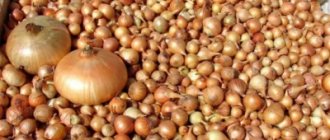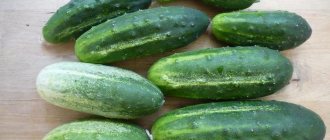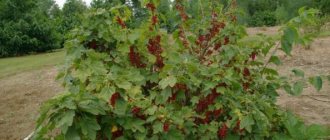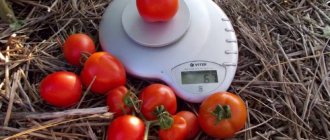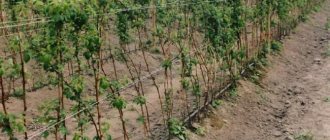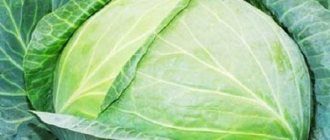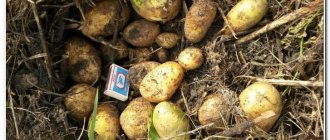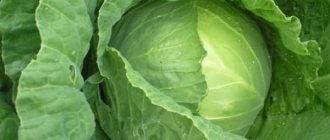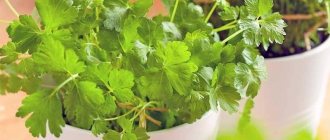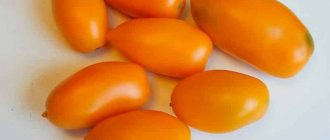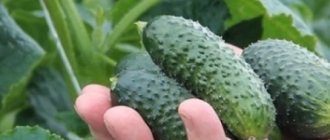Vegetable growing » Cabbage
0
944
Article rating
Kira Stoletova
One of the representatives of ultra-early varieties is Nozomi cabbage. Gardeners fell in love with it due to its excellent adaptability to unfavorable growing conditions, as well as its undemanding nature of soil. The crop gives good yields even at low temperatures.
Description of Nozomi cabbage f1
Description of Nozomi cabbage
Nozomi F1 is one of the earliest cabbage varieties. The growing season from planting seedlings to harvesting is only 50-60 days. Thus, if you sow the seeds in March, by the end of May you will be guaranteed a delicious, vitamin-rich fresh cabbage salad.
Nozomi F1 cabbage is characterized by high yield and forms dense forks like many mid-season varieties. The weight of a head of cabbage can reach 2.5 kg. About 90% of the entire harvest of this cabbage is marketable; it is stored on the root for a long time. Nozomi F1 tolerates transportation well, but does not last long, like most early ripening varieties.
The leaves of Nozomi F1 cabbage have a greyish-green tint, they are bubbly with a slight wave along the edge. Upon closer inspection, you will notice a thin waxy coating. The heads of cabbage have a round or flat-round shape, the cut is yellowish-white. If we evaluate their density on a 5-point scale, the Nozomi F1 variety can safely be given 4.5 points. The inner stalk is medium, the protruding outside is short. The average weight of a head of cabbage is 1.3-2 kg. Cabbage forks of the Nozomi F1 variety are not prone to cracking even with excessive watering.
Origin story
Nozomi cabbage f1 was obtained at a breeding station in France and these seeds were allowed for official registration in the State Register of the Russian Federation in 2007. Although if a person purchasing seeds in factory packaging reads the information printed there, he will be surprised to see that Nozomi cabbage seeds are produced in Japan. There is no contradiction in this.
Attention! , founded more than a hundred years ago in the Japanese city of Yokohama, opened a breeding station in France back in 1998, and in 2003 completely moved its head office from all over Europe to France.
Thus, many of the seeds that we receive from this company can be produced both in France and in other European countries.
Nozomi cabbage seeds were recommended for use in the North Caucasus region. Despite this, the Nozomi cabbage hybrid is grown in many regions of our country, including under spring film covers.
Characteristics of Nozomi cabbage f1
Nozomi cabbage seedlings are characterized by high growth vigor. The variety is unpretentious in cultivation and has good commercial and taste qualities.
Productivity and fruiting
From sowing seeds for seedlings to planting cabbage in a permanent place, it takes about 1.5-2 months. After another 55-58 days, you can harvest the first harvest. It is advisable to cut off the heads of cabbage immediately before eating, since the variety does not have good shelf life, but retains its taste and appearance for a long time, remaining on the root.
One plant can form a head weighing more than 2 kg; from 1 m² you can collect 10-12 kg. In the description of Nozomi cabbage, the variety is positioned as suitable for industrial cultivation, so it would be useful to indicate the yield per 1 hectare - it is up to 31.5 tons.
The yield of cabbage is not only mass indicators, but also the quality of the vegetable. The head of cabbage should not be cracked, eaten away by caterpillars and slugs. You can increase crop productivity by following the basic rules of agricultural technology:
- At the time of transplantation into open ground, seedlings should be healthy, without thickening and overfeeding with nitrogen fertilizers.
- Plants transplanted later than expected will be less productive.
- Seedlings infected with blackleg or other diseases will not produce a good harvest.
- Cabbage plantings do not tolerate shading.
- It is necessary to adhere to a strict scheme so that the plants are not too crowded. For early ripening varieties and hybrids, 5-6 pieces per 1 m² are optimal.
Application area
Nozomi cabbage has a delicate, pleasant taste. It is consumed mainly fresh, but is also added to soups, stewed and pickled. This hybrid is not intended for long-term storage and pickling. When pickled and salted, the product quickly deteriorates.
Resistance to diseases and pests
The variety is resistant to diseases such as:
- Alternaria blight;
- bacterial rot.
Cabbage has a lot of pests - cruciferous flea beetle, cabbage fly, slugs. For prevention, you can periodically sprinkle the plantings with wood ash or use tobacco, or cover the cabbage with lutrasil.
Advice! To repel unwanted insects, dill, carrots, celery, and marigolds are planted in the beds.
Advantages and disadvantages of the variety
Hybrid Nozomi F1 is in a leading position among early varieties due to its undeniable advantages:
- fast and friendly ripening of heads of cabbage;
- high productivity;
- marketable condition;
- possibility of transportation;
- resistance to cracking due to excess moisture;
- undemanding to growing conditions;
- high immunity to major Cruciferous diseases;
- resistance to short-term frosts;
- great taste.
The disadvantage of this variety of cabbage is its short shelf life and the impossibility of using it in winter preparations.
Reviews from gardeners
Valentina Igorevna, Moscow, 54 years old.
I have already bought Eliza F1 (Sakata) seeds and will try to grow them. I will compare it with Nozomi, an unchanged variety for me, which I have been growing on my plot for a long time. I’ve never had it burst, it’s very tasty, especially in borscht and salads. Let's see how Eliza shows herself.
Dmitry Vladimirovich, Kyiv, 45 years old.
All the time I grew the hybrid Nozomi f1. But my neighbor constantly says to try Magnus f1. I have a small plot, there is no opportunity to grow different varieties of cabbage. I am 100% confident in Nozomi. The Frenchwoman has never let us down. But with Magnus only according to the neighbor. Yes, he showed the heads of cabbage, they are good, but he also has regular watering and is constantly digging into the ground and fertilizing it. And I have work in the city, so I’m rarely at the dacha.
Growing rules
The Nozomi F1 variety can be grown in open ground in the southern regions of Russia, as well as in areas with a more severe climate, using film shelters. This hybrid is undemanding in terms of soil composition, however, by creating optimal conditions for it, you can get the highest possible yield.
Planting seedlings
Cabbage seeds are sown for seedlings in late February - early March. It is better to use an outdoor greenhouse, in this case the seedlings will be stronger. When grown at home, seedlings can become very elongated.
Before planting, seeds are disinfected in a weak solution of potassium permanganate, hardened by placing alternately in hot and cold water, and, if desired, germinated by wrapping them in damp gauze, cotton wool or cotton cloth.
Wide boxes or containers are suitable for growing cabbage seedlings. The soil is prepared from turf soil and humus, taken in equal parts. Fertilizers are added to the soil mixture per 10 kg:
- superphosphate – 15 g;
- ammonium nitrate – 15 g;
- potassium chloride – 6 g.
The seeds are placed in the ground to a depth of 1.5 cm, sprinkled on top, moistened with a spray bottle, covered with film or glass and placed in a warm, well-lit place.
Shoots appear after 5-7 days, after which the film is removed. When the seedlings have formed 1 pair of leaves, the containers are moved to a cooler place with a temperature of 13-15°C, and at the same time, picking is carried out. 2 weeks before planting in open ground, seedlings begin to harden by taking them out into the fresh air.
Transplantation into open ground
The best predecessors of cabbage are legumes and grains, cucumbers, pumpkin, onions, and root vegetables. The place should be open to sunlight, but without drafts. The bed is prepared in the fall. The soil is dug up and organic fertilizers are added:
- humus;
- compost;
- manure.
In mid-spring, the soil for cabbage is fertilized with products containing large amounts of potassium and phosphorus. Cabbage shows the greatest productivity on fertile light loams.
In mid-May, when the night air temperature does not drop below +10°C, cabbage seedlings are placed in a permanent location. By then the plant should be about 15-20 cm tall and have 7-8 leaves.
In the garden bed, dig holes 15-20 cm deep, following the 50*50 pattern. Organic and mineral fertilizers are placed at the bottom:
- humus – 0.5 kg;
- ammonium nitrate – 3 g;
- superphosphate – 7 g;
- potassium salt – 4 g.
Planting is carried out in cloudy weather or in the evening. The seedlings are buried down to the cotyledon leaves, the soil is lightly pressed down and watered abundantly.
Warning! Cabbage should not be planted in the same place year after year.
The crop releases mycotoxins, marking the boundaries of its root system in the soil. Over the course of several years, they accumulate and begin to oppress her. Also, observing crop rotation is a good prevention against mole crickets and cabbage flies.
Aftercare
Nozomi cabbage should be watered regularly and abundantly (at least 2-3 liters per plant). The soil should be moistened to a depth of about 0.5 m. During dry and hot periods, watering should be at least once every 2 days. After drying, the soil is loosened for better breathability.
2 weeks after planting, young cabbage is fed with mullein diluted with water (1:7) and bird droppings (1:15). Each bush requires 1 liter of solution. Nozomi is fed 2 more times per season with complex mineral fertilizers.
Care
Caring for this crop is divided into several stages:
- The first stage begins when the first leaves appear on the seedlings. During this period, it is necessary to carefully care for future cabbage. Seedlings are treated with wood ash to protect them from all kinds of parasites. Water it once every 10 days, and each watering is subsequently accompanied by loosening the soil. Loosen the soil shallowly so as not to damage the root system of the plant. After the leaves form, the plant is fed with nitrogen-containing fertilizers.
- The second stage lasts from the formation of leaves to the beginning of the formation of heads of cabbage. During this period, nitrogen-containing fertilizers and irrigation play an important role. In addition to watering, do not forget to loosen the soil and remove weeds. It is also worth noting that at the second stage the crop is most vulnerable to pests and diseases. Therefore, you need to be prepared to fight. It is advisable to use non-chemical agents to combat parasites and diseases.
- The third stage occurs when the cabbage rows close together. At this moment, the entire bed is covered with leaves. At this stage, the plant becomes quite strong and does not require special attention. There are only two nuances. If there are few cabbage “heads” (cabbage is grown for home consumption) and there are no plans for long-term storage of the heads, you can water them almost until harvest. Then the heads of cabbage will be more juicy. If it is necessary to increase the shelf life of cabbage and protect the “heads” from cracking, then stop watering the vegetable 2 weeks before the planned harvest.
Pest and disease control
Nozomi cabbage may be susceptible to diseases such as:
- downy mildew (peronosporosis);
- blackleg;
- kila.
All these diseases are fungal in nature. The fight consists in treating plants with copper-containing preparations, for example, Bordeaux mixture. A lime solution helps a lot. Among the biofungicides, Trichodermin is especially important.
Cabbage plantings are often affected by the white butterfly, moth, cutworm, and cruciferous flea beetle. Plants are treated with an ash-soap solution, tincture of wormwood, tobacco, and dandelion root. Of the chemicals, Kinmiks is the best.
To prevent slugs from attacking the cabbage, sprinkle the ground under the bushes with black pepper, dry mustard, and ground eggshells.
Many diseases begin to progress on weakened plants, where the rules of agricultural technology are grossly violated. By following the basic principles of growing cabbage, you can avoid many problems.
Harvest and storage
Depending on the growing region, the heads of cabbage reach maturity in late May or early June.
How and when to collect
The harvest is harvested 2 months after planting the seedlings in the ground, carefully cutting off the heads of cabbage along the stem with a sharp knife.
Cabbage is stored well in the garden and does not crack, so let’s harvest it 5-8 days later than the recommended period.
Storage features and shelf life
The collected heads of cabbage are inspected for damage or pests and dried under a canopy.
Nozomi F1 is stored in a cool, dry place with good ventilation. This cabbage can be stored for no more than 2 months, so it must be sold or consumed as soon as possible.
Rules for planting seedlings in the ground
The place for early cabbage is prepared in the fall by carefully digging up the area with organic compounds: humus, manure or compost. In April, mineral fertilizers containing potassium and phosphorus are applied to the garden bed.
Recommendations for planting:
- The optimal time for planting cabbage is the beginning - mid-May.
- The vegetable planting pattern is 50x50 or 60x60 centimeters.
- Before planting, humus (500 grams), ammonium nitrate (3 grams), superphosphate (7 grams), and potassium salt (4 grams) must be added to each hole.
- To loosen the soil, it is necessary to pour 0.5 buckets of river silt into the holes.
- Cabbage bushes are planted deep down to the cotyledons.
- The seedlings need to be well watered.
- Seedlings take root better when planted in cloudy weather, in the morning or evening.
Read also: Vegetable physalis for the winter - recipes
The procedure for growing seedlings and transplanting them must be carried out correctly. Only then can one hope to obtain rich harvests of early ripening vegetables.
Advantages of the variety, reviews about it
The early ripening cabbage variety Nozomi is chosen by those who fully appreciate the advantages of the hybrid:
- rapid maturation of forks
- density of heads of cabbage, juiciness of yellowish inner leaves
- high yield varieties
- resistance to adverse weather conditions, a number of fungal diseases
I have been looking for a new and interesting variety of cabbage for a long time, and they recommended the Nozomi variety. Cabbage really has many benefits. It ripens quickly, has round and compact heads, as well as dense leaves and heads. I grew cabbage in open ground, it did not crack and gave an excellent harvest. I recommend it.
From personal experience, I would like to note that Nozomi cabbage is truly an excellent variety. I have a small plot, so I try to grow only the best varieties of vegetables. Nozomi cabbage heads are beautiful green in color and have excellent taste. It is unpretentious to grow and makes excellent fresh summer salads and cabbage rolls.
More information can be found in the video:
Read also: Forsythia intermedia Linwood
Description and characteristics of the variety
White cabbage Nozomi is an ultra-early ripening hybrid. Seedlings grow from seeds in about a month. Then, 55–58 days after planting in the ground, the heads of cabbage ripen. So, seeds sown in March will give a good harvest at the end of May.
The seedlings are not afraid of frost and are suitable for open and protected ground.
The leaf rosette is located horizontally or slightly in a raised position. The leaves are small, round in shape, with wavy edges. The surface is glossy, bubbly, with a slight waxy coating. The heads of cabbage are spherical, compact, very dense. Density score: 4.5 points. Weight - 1–1.8 kg. The inner and outer stalks are short. The leaves are very juicy and tasty.
The color of the outer leaves is green, in cross-section - white with a yellow tint.
The variety produces high yields - 315 c/ha, about 10 kg/m². Moreover, 90% of the collected heads of cabbage have a marketable appearance. Cabbage heads can remain on the field for quite a long time without cracking. They transport well. But the variety is not intended for long-term storage. The vegetable is suitable for preparing fresh salads, stews and soups. Not suitable for pickles.
Did you know? From a botanical point of view, a head of cabbage is a huge bud, which is formed on a kind of stalk.
The best varieties of cauliflower for central Russia
Today it is impossible to imagine a Russian’s home garden without at least several varieties of cauliflower. This tasty and beautiful vegetable has been winning its place in the sun for decades to achieve the popularity it currently has.
Cauliflower is one of the most valuable types of this vegetable. But, at the same time, this crop is the most difficult and capricious to grow, since it is very demanding in terms of nutrition, soil, watering, temperature and lighting. Cauliflower is characterized by high taste, nutritional and dietary qualities, so it is widely used for preparing various dishes, frozen and canned.
As a rule, different varieties of cauliflower are eaten. The white head is most often used, but you can also use its leaves, which are rich in nutrients - they contain a lot of protein, potassium, iron, phosphorus and calcium and vitamins B1, A, B2, PP, K.
The best varieties of cauliflower require good fertile soil that is rich in humus. If grown on light soils, apply a lot of manure and constantly water the plants.
In our country, for cultivation, you should purchase early varieties of cauliflower or a mid-season group. Usually they are all considered first-generation hybrids of foreign selections. These cauliflower varieties have a growing season that lasts approximately one hundred and twenty days. These include the following varieties: Goodman, Bite Rock, Robert F1, Candid Charm, Profil. Hybrid varieties of cauliflower also grow successfully in our soil: F1 Aviso, Ameising, Lateman, Asterix, Montano Barsak, Malimba, Fargo, Palace, Syria, Fremont.
Early ripening varieties include Amphora and Moscow Canning. In addition, some of the best varieties of cauliflower are considered to be Early Gribovskaya 1355, Garantiya and Otechestvennaya, which must be sown in a greenhouse or nursery. The Alpha variety, which has good heads - dense, smooth and white, showed good results.
An excellent harvest in just sixty days is brought by the early ripening variety Movir 74, which has round, medium-sized and large heads. The average weight of the head is from four hundred grams to one and a half kilograms. This variety is characterized by cold resistance and heat tolerance, and has excellent taste.
One of the best varieties of the early period can be called Express, which can be planted under a film covering and in open ground. To get a good quality harvest under film or glass, or in open ground, you need to buy only early varieties that have a short development period. In the presence of unfavorable conditions (which are so characteristic of our domestic climate), they form so-called pre-buds - low-quality, small buds with premature development. For early cultivation in open ground conditions, you need to know whether the climate of the area is suitable for this variety of cauliflower.
A good harvest in central Russia is given by mid-early varieties of cauliflower (Otechestvennaya, Garantiya), mid-season varieties (spring Adlerskaya and winter Adlerskaya) and the Sochinskaya variety, which is mid-late. In addition, for universal cultivation, mid-early varieties are suitable for open ground, which can be planted from April to July. These include the mid-season Graffiti variety. The period from germination to consumption is approximately one hundred and twenty days. This variety of cauliflower is characterized by a large, rounded head that is purple in color. Graffiti is an extremely bacteriosis-resistant variety.
fb.ru
Plant yield
The plant's productivity is quite high. The great advantage of this crop is that after just a month and a half you can harvest the first fruits. From one square meter, with proper care, you can collect from five to ten kilograms.
Experts recommend cleaning immediately before using the product, this will maximize the preservation of all its beneficial properties and juiciness.
If you make the correct cut, then after a month and a half you can harvest again. To do this, when harvesting a head of cabbage, it is important to leave six to eight lower leaves. Then it is necessary to fertilize with mullein.
Properties of the Nozomi hybrid
Nozomi is one of the earliest ripening hybrids. After transplanting the seedlings into the OG, the heads of cabbage reach technical maturity in 50-60 days.
But early ripening is not the only feature of the hybrid. Nozomi has high yields. From 1 hectare of plantings you can collect about 31-32 tons of products. The ripening of the crop occurs evenly and amicably. This is a big advantage when growing vegetables on an industrial scale for the purpose of selling them on the market.
The output of commercial products is at a high level. Approximately 90% of the harvested crop is suitable for sale.
The vegetable bush is strong and has good growth energy. In addition, the plant is quite unpretentious to cultivation conditions. The leaves of the plant are small, gray-green in color, and vesicular. There is slight waviness along the edge of the leaf. There is a medium-intensive waxy coating.
The hybrid forms good heads of cabbage with the following characteristics:
- Round shape.
- Weight is about 1.5-2.0 kg.
- Good density. Out of 5 points, Nozomi was given 4.5 points.
- The outer color of the “head” of the hybrid is green, in cross-section it is yellowish-white.
- The inner stump is medium long, the outer one is small.
- Vegetables are not prone to cracking.
- Has excellent taste.
- “Heads” are stored on the site for a long time, even after the onset of technical maturity.
- They are not afraid of transportation due to their high density.
In addition, it is worth noting other features of this hybrid. First of all, this cabbage is recommended for fresh consumption, since the “heads” have a short shelf life.
Also, Nozomi is resistant to diseases such as Alternaria and bacterial rot.
Advantages and disadvantages
From the reviews of gardeners it follows that the number of advantages of the variety outweighs the number of disadvantages.
- The advantages include:
- high productivity;
- unpretentiousness;
- rapid ripening, which is suitable for cold regions;
- amicable maturation;
- cold resistance;
- immunity to Alternaria and bacterial rot;
- excellent taste;
- high density of forks;
- crack resistance;
- marketable condition;
- transportability.
- Minuses:
- inability of heads of cabbage to be stored for a long time.
Varieties and types
click to open list
To the begining
- Albatross F1
- Alaska F1
- Amager 611
- Aros F1
- Atena
- Belorusskaya 455
- Biryuchekutskaya 138
- Wineglass
- Broccoli
- White ball
- White rock
- Vienna white 1350
- Vertue 1340
- Violeta
- Vitamin
- Galaxy F1
- Guarantee
- Giant
- Grenadier F1
- Ditmarskaya early
- Dithmarscher Frewer
- Curl F1
- Wintering 1474
- Golden early
- Golden hectare 1432
- June
- Cadet
- Cossack F1
- Calibos
- Decorative cabbage
- Karamba F1
- Cartago F1
- Casio
- Kilor F1
- Chinese
- Kolobok F1
- Copenhagen market
- Cortez F1
- Krautman F1
- Crewmont F1
- Kubanochka
- Quisto F1
- Langedijker winter
- Ice Prince F1
- Lying F1
- Lennox F1
- Linda
- Maximus F1
- Malachite F1
- Marathon F1
- Mars MC
- Marfa
- Midor F1
- Mila F1
- MOVIR 74
- Montano F1
- Montop F1
- Moskovskaya late 15
- Hope
- Nika F1
- Nozaki
- Nozomi F1
- Number one Gribovsky 147
- Pak-Choi
- Password F1
- Pegasus F1
- Python F1
- Present
- Premium F1
- Ramco F1
- Review F1
- Regent
- Resistor F1
- Rinda F1
- Robustor F1
- S-217 Jubilee F1
- SB-3 F1
- Siberia F1
- Slava 1305
- Snowball 123
- Solo F1
- Space Star F1
- Stardon F1
- Start F1
- Sphere F1
- Tertes F1
- Transfer F1
- Kharkov winter
- Cha-Cha F1
- Bowl
- Shannon F1
- Express MS
- Extra F1
- Erdeno F1
- Etna F1
- Julius F1
- Junior F1
To the begining
SLAVA 1305
White cabbage. For short-term storage. Productivity up to 12.5 kg/sq.m. For open ground. Planting pattern: 70 cm x 45 cm. Ripening time: mid-season: from germination to harvesting 116 days. Fruit: heads of cabbage are round and round-flat, dense, large, weighing 4.3-4.5 kg, excellent taste. Medium sized inner stump. The upper leaves of the head of cabbage are pale green. Moderately resistant to major cabbage diseases, resistant to cracking. For pickling and fresh use. Heads of cabbage are stored until the beginning of January (for 3 months). Seeds. White cabbage “Slava 1305”, for pickling (weight: 0.3 g)
The Slava 1305 variety is especially valued for its high yield. Due to the fact that the heads of cabbage are stored until January without changing quality, you can extend the period of consumption of fresh cabbage. Heads of this variety are suitable for fresh consumption immediately after harvest, but even after storage they do not lose their excellent taste. The heads of cabbage variety Slava 1305 are marketable, dense, and suitable for sale on the market.
Return to www.common.narod.ru
How to choose white cabbage varieties
Sowing season is in full swing, and summer residents have a lot to do. All the window sills are filled with various seedlings that are waiting in the wings. Not many gardeners can find a place to plant cabbage seedlings at home. How to be? You can sow cabbage in a greenhouse, or directly into the ground, but the most popular solution is to purchase ready-made seedlings.
We have already discussed how to choose and buy seedlings correctly; we found out 12 secrets of growing cabbage seedlings, and in the article Cabbage, we not only looked at all the important features of this popular crop, but also talked about how to grow cabbage without seedlings, by sowing its seeds directly in the ground or in a greenhouse
But we missed one no less significant question: how to choose varieties of white cabbage, how they differ from each other, and what to look for when choosing. I propose to correct this omission
What varieties are there and how do they differ?
Before choosing a cabbage variety, you need to decide what exactly you need it for: for early fresh use, for pickling and canning, or for long-term storage.
Early varieties
Early varieties of cabbage are not particularly productive and are only suitable for fresh consumption. Its heads of cabbage grow small and quite loose, and when they overgrow, they usually crack. But although such cabbage is not suitable for processing and long-term storage, it is impossible to replace it - after all, it ripens in just 60-80 days after planting the seedlings in the ground.
However, it is too late to sow early cabbage seeds even in the ground now - it is better to buy ready-made seedlings. The most popular early varieties are: Golden Hectare, Zora, Rosava, Yaroslavna, Nakhodka, and among the hybrids: Aladdin, Vestri, Delphi, Transfer, Pharaoh, Express.
Medium varieties
Medium varieties of cabbage, which are conventionally divided into mid-early, mid-season and mid-late, are something between cabbage of early and late varieties. Compared to the former, they are more productive, have a denser head, but are not as delicate in taste and ripen much longer: 85-120 days pass from planting seedlings in the ground to harvesting. Late varieties are inferior in yield and shelf life.
An undeniable advantage of medium varieties is the ability to use them for subsequent processing: pickling, canning, and so on. The most popular mid-season cabbage varieties include: Podarok, Slava 1305, Stolichnaya, Belorusskaya 455, Braunshveitskaya. Among the hybrids we can distinguish Megaton, Menza, Rinda, Haniball, Hermes and others.
Late varieties
Late varieties are the most productive. In addition, they have excellent taste and are less prone to accumulating nitrates than others, which means they are the safest for our health. They are suitable for both fresh use and processing.
Distinguished by its increased shelf life, cabbage of late varieties, when properly stored, remains fresh until the next season. True, it takes quite a long time to ripen: more than 130 days pass from planting its seedlings in the ground to harvesting. The most popular among late-ripening cabbage varieties are: Kamenka, Turyuza plus, Khalif, Sugarloaf, Belosnezhka; Among the hybrids: Aros, Atria, Bartolo, Extra, Lennox.
Zoned varieties are always better
Whatever cabbage varieties you ultimately choose: late, early or mid-season, always try to give preference to the zoned ones. The thing is that in each region and even region, weather conditions are different, and those varieties that grow well, for example, in the Tver region, will be less productive in the Vologda region, and vice versa. Thanks to planting zoned varieties, you are guaranteed to be able to get the maximum yield of high-quality heads of cabbage, because these varieties are bred taking into account the conditions of a specific area.
How do you choose cabbage varieties? And what varieties do you prefer?
Tatiana
And I like the Sugarloaf variety, and also Extra.
Marina, Nekrasovskoe
And from the early ones I like Express and June, and from the late ones - Vyuga (to be absolutely precise, it belongs to the middle late ones) and Stone Head. By the way, last year it was the latter that was the only one that survived the sharp transition from summer drought to autumn rains without losses - the heads of cabbage did not crack. This year I also sowed Podarok (mid-late) and Kharkov winter (late variety) - we’ll see...
Tatiana
This year I also decided to try planting the Stone Head, everyone praises it very much.) And I planted the Kharkov winter one 2 years ago, with purchased seedlings, also a very good variety with dense, very juicy heads of cabbage - I liked it.
Disease resistance
Diseases are typical for a given crop only in two cases: if the growing season was carried out incorrectly or care rules were not followed.
Diseases characteristic of cabbage are listed in the table.
| Clubroot fungus | Due to excessive watering, the acidity in the soil increases and the fungus multiplies. The disease manifests itself due to external factors, the cabbage grows slowly, the leaves begin to wither, and lumps and growths form on the root system. To remove the infection, you should destroy the affected cabbage and disinfect the soil with Bordeaux mixture. |
| Dry rot | The disease reveals itself by the formation of gray spots on the foliage and a black stalk. If the fungus penetrates deeply, the head of cabbage becomes rotten and unsuitable for consumption. To prevent the disease, seedlings should be treated with wood ash once a week for 21 days. |
| Gray rot | This disease affects vegetables after harvest. To avoid this, you need to periodically inspect the heads of cabbage and ventilate the room in which they are stored. |
| Bacterial infection | The disease infects the vessels of cabbage. Symptoms are: the development of an unpleasant odor and the formation of mucus on the surface of the foliage. This disease is typical if the soil area has a lot of nitrogen, a lot of moisture, or there have been sudden changes in temperature. |
| Sclerotinia | Develops due to prolonged cold rains. Manifested by rotting of the fork. |
| Necrosis | The disease develops if excess fertilizer is added. The onset of the disease is indicated by the formation of small black dots on the head of the cabbage. |
In addition to diseases, pests that are dangerous for cabbage are:
- Cabbage fly. When examining the plant, white larvae can be found. Most often they feed on the root system and stem tissue. To avoid fly infestation, you need to treat the area around the hole with mothballs, ash and tobacco dust. All substances are added in equal proportions.
- Owl butterfly. This insect is brown in color and has longitudinal stripes on its abdomen. Caterpillars are especially dangerous; they crawl deeper and deposit green excrement there. If you regularly spray with insecticides, damage will not occur.
- White butterfly. To combat this, you can plant calendula or marigold flowers next to cabbage. Butterflies cannot stand the smell of these plants and do not fly close. If there are no such flowers, you can treat the bushes with mustard or vinegar.
- Aphid. Foliage damage occurs. It is necessary to spray the vegetable with solutions based on wormwood and tobacco.
In each case, you need to periodically review the condition of the bushes and take timely measures if certain symptoms appear.
Early cabbage: 10 best varieties. Rating of the most productive varieties of early cabbage
Cabbage is a vegetable crop that cannot be called difficult to grow. Knowledge of the basic rules of planting, care and possession of basic information about choosing a variety will allow every gardener or summer resident to grow an excellent harvest, which will be enough for the whole family until the next season.
The main thing is to be guided by certain criteria when choosing a variety.
It is necessary to take into account the climate of a given area and the actual duration of summer, since each variety has its own individual ripening period, and this is decisive when choosing a planting method. If the warm season is short, you need to choose the seedling method, and in the southern regions with long and warm summers - the seedless method.
- You need to know exactly what the harvest will be used for - for pickling and canning, for consumption only fresh, for long-term storage. In each case, you can choose a suitable variety based on taste and keeping quality criteria.
- And another important criterion is productivity. It is very important if you plan to provide your family with large supplies of this vegetable or start selling your products. In this case, winter varieties are usually chosen.
Main features of early varieties
- Early ripening dates are from two and a half to four months from the moment the seedlings appear.
- Short-term storage: both fresh and fermented.
- The main application is fresh salads, first and second courses.
- Unsuitable for winter storage.
- Instability to cracking when overripe.
- Low yield.
10 best early ripening cabbage varieties
- “Transfer” is an early ripening hybrid, shape – round, density – average, weight – no more than one and a half kilograms, simultaneous ripening of the crop, does not crack, is resistant to diseases, short shelf life.
- “Ditmarskaya early” - ripening period - three and a half months, not resistant to cracking, shape - round, density - medium, weight - one and a half to two kilograms, consumed fresh and canned.
- “Copenhagen Market” is a medium-yielding variety, weight – up to two and a half kilograms, ripening period – one hundred days, tolerates light frosts, grown in seedlings, shelf life – no more than one month.
- “Iyunskaya” - ripens within three to three and a half months, shape - round, density - medium, weight - two - two and a half kilograms, prone to cracking, taste - delicate and juicy.
- “Dumas” is a hybrid variety with a very short ripening period - about three months, does not crack, weighs up to one and a half kilograms, suitable for greenhouse cultivation.
- “Malachite” is a hybrid with high resistance to transportation, weight – up to two kilograms, juicy and tender leaf, does not crack, gives a high yield.
- “Zarya” is a hybrid variety with active fruiting, weight – one and a half to two kilograms, shelf life – no more than four weeks, excellent taste in fresh and canned form.
- “Kazachok” is a hybrid variety with high yield and good resistance to disease, cold and cracking, ripens in about one hundred and twelve days, average weight is just over one kilogram.
- “Parel” is a high-yielding, very early variety, ripens in three months, weighs two kilograms, shelf life is about two months, suitable for greenhouse cultivation.
- “Golden Hectare” is a high-yielding variety of light green color with a weight of about two and a half kilograms and a ripening period of about one hundred and ten days, a dense structure, a shelf life of up to five months.
